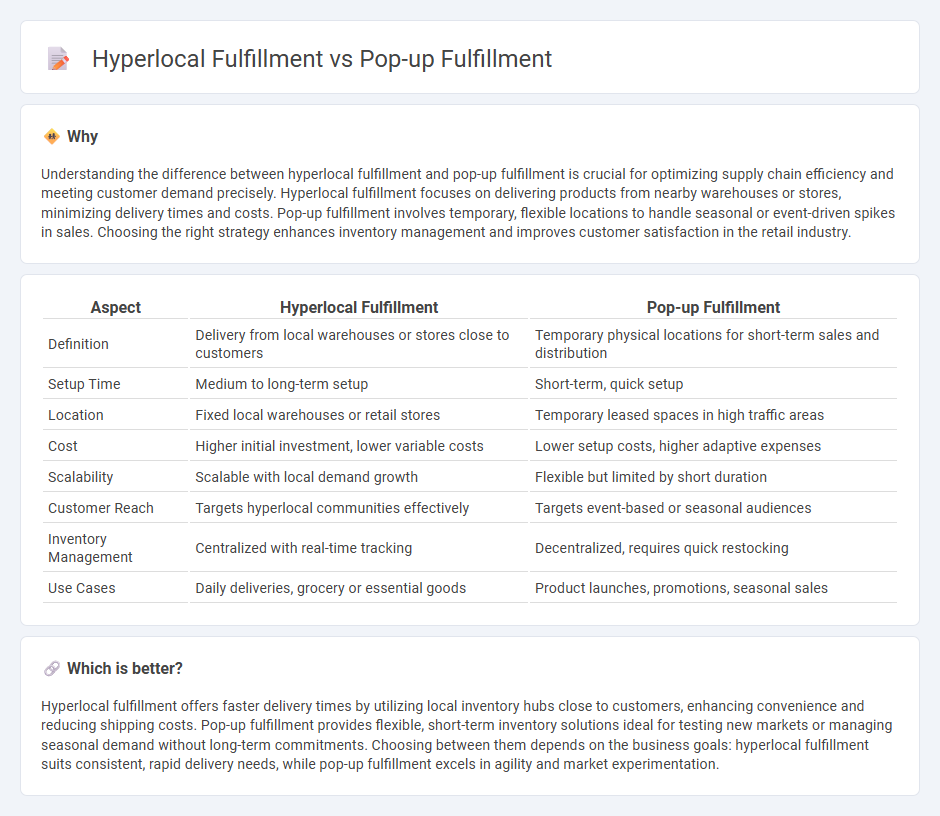
Hyperlocal fulfillment leverages localized inventory and delivery networks to rapidly serve consumer demands within specific geographic areas, enhancing convenience and reducing shipping times. Pop-up fulfillment involves temporary, flexible retail setups that capitalize on high-traffic locations or events to boost brand visibility and drive immediate sales. Explore the advantages and strategic applications of hyperlocal versus pop-up fulfillment to optimize retail operations.
Why it is important
Understanding the difference between hyperlocal fulfillment and pop-up fulfillment is crucial for optimizing supply chain efficiency and meeting customer demand precisely. Hyperlocal fulfillment focuses on delivering products from nearby warehouses or stores, minimizing delivery times and costs. Pop-up fulfillment involves temporary, flexible locations to handle seasonal or event-driven spikes in sales. Choosing the right strategy enhances inventory management and improves customer satisfaction in the retail industry.
Comparison Table
| Aspect | Hyperlocal Fulfillment | Pop-up Fulfillment |
|---|---|---|
| Definition | Delivery from local warehouses or stores close to customers | Temporary physical locations for short-term sales and distribution |
| Setup Time | Medium to long-term setup | Short-term, quick setup |
| Location | Fixed local warehouses or retail stores | Temporary leased spaces in high traffic areas |
| Cost | Higher initial investment, lower variable costs | Lower setup costs, higher adaptive expenses |
| Scalability | Scalable with local demand growth | Flexible but limited by short duration |
| Customer Reach | Targets hyperlocal communities effectively | Targets event-based or seasonal audiences |
| Inventory Management | Centralized with real-time tracking | Decentralized, requires quick restocking |
| Use Cases | Daily deliveries, grocery or essential goods | Product launches, promotions, seasonal sales |
Which is better?
Hyperlocal fulfillment offers faster delivery times by utilizing local inventory hubs close to customers, enhancing convenience and reducing shipping costs. Pop-up fulfillment provides flexible, short-term inventory solutions ideal for testing new markets or managing seasonal demand without long-term commitments. Choosing between them depends on the business goals: hyperlocal fulfillment suits consistent, rapid delivery needs, while pop-up fulfillment excels in agility and market experimentation.
Connection
Hyperlocal fulfillment leverages proximity-based inventory hubs to deliver products rapidly within specific neighborhoods, enhancing customer convenience and reducing last-mile delivery costs. Pop-up fulfillment centers act as temporary, strategically located points that support hyperlocal distribution by expanding storage capacity and meeting demand spikes during peak shopping periods. This synergy allows retailers to optimize supply chain agility and improve service levels in densely populated urban areas.
Key Terms
Temporary Warehousing
Pop-up fulfillment leverages temporary warehousing to quickly meet sudden spikes in demand, enabling brands to position inventory closer to key markets without long-term leases. Hyperlocal fulfillment emphasizes permanent or semi-permanent micro-fulfillment centers within dense urban areas to ensure rapid delivery, often within hours. Explore the advantages of temporary warehousing in pop-up fulfillment to optimize your supply chain agility and customer satisfaction.
Proximity Logistics
Pop-up fulfillment centers enhance proximity logistics by enabling rapid order processing near high-demand urban areas, reducing delivery times and shipping costs compared to traditional warehouses. Hyperlocal fulfillment leverages micro-warehouses and local inventory to offer same-day or even hour delivery, capitalizing on close geographic proximity to customers. Explore how these strategies optimize supply chains and boost customer satisfaction in your region.
On-Demand Inventory
Pop-up fulfillment leverages temporary, location-specific inventory to meet short-term demand surges, optimizing immediate order processing in high-traffic areas. Hyperlocal fulfillment utilizes nearby warehouses and stores to deliver products rapidly within a defined geographic radius, enhancing customer convenience and reducing last-mile delivery costs. Explore more about how on-demand inventory strategies can transform your supply chain efficiency.
Source and External Links
Pop-up Distribution Centers - PFS Commerce - Pop-up fulfillment centers are temporary, localized distribution operations that help brands decentralize their fulfillment to meet fast delivery demands cost-effectively, ranging from small in-store setups to larger operations in 3PL warehouses.
Pop-Up Warehousing: Definition, Risks, and Benefits - Pop-up fulfillment refers to the use of temporary or underutilized spaces converted into micro-fulfillment centers that enable businesses to flexibly scale storage and distribution capacity according to seasonal or market demand peaks without committing to long-term facilities.
Staffing Considerations for Pop-Up Fulfillment Centers - Pop-up fulfillment centers are short-term, supplemental facilities used especially during peak seasons to handle volume spikes, requiring a flexible, scalable workforce often supported by specialized staffing providers to maintain service and speed without disrupting permanent operations.
 dowidth.com
dowidth.com